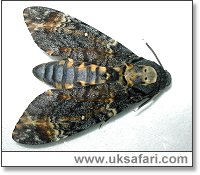
|

|
|
 Sent
to you Sent
to you
by e-mail
|
|
Simply
enter your details and hit the send button
more
info |
|


Click Here

Links
Advertise
Terms of Use
Contributors
About Us
Contact Us
|
 |
Go back
 | Bookmark
| Bookmark
 | Print Page
| Print Page  | E-Mail Us
| E-Mail Us 
Hand Rearing a Death's-Head
Hawk-Moth
by Pam Benjamin
 Photo: Pam Benjamin
Photo: Pam Benjamin
|
|
UK
Safari Tip:
You can discover more about Hawk-Moths and their caterpillars with this
fold out chart - click here
|
|
A very large, green, speckled, thick, noisy caterpillar turned up on our patio being played with by the cats.
It would coil and thrash itself from one side to the other with quite a large thump. I was totally flummoxed by this beast. I put a plastic flower pot over it to stop the cats getting at it, then noticed the flower pot moving along the ground, so I weighed it down with a heavy stone. Eventually I got it identified on the Internet as a Death's Head Hawk-Moth, and had it confirmed by Dan at Butterfly Conservation in Dorset. He suggested it was looking for an area to pupate.
It wandered the length and breadth of the patio, not eating for 2 days, so eventually I put it in an old aquarium with some dry soil and leaf litter in the bottom. I also put in a piece of potato, just in case it was hungry. An hour later there was no sign of beast. It had burrowed under the leaf litter and gone into the pupation stage.
Not a lot happened for the next couple of weeks. You can apparently leave it under the earth until the following spring, but the likelihood of it finding a mate then is slim.
Four weeks later I noticed he'd hatched. The wings were extended and dry, so he’d obviously emerged a few hours before. I am so sad that I have missed the actual hatching as they emit a distinctive squeak just before hatching. Trying to move him was really nerve wracking. Every time I touched him he would squeak. It's an almost mechanical noise. It only has 3 to 4 days to live and find a mate so that evening, after a few photos I released him. It was a fascinating experience, all too quickly gone. I think of the warm orange colour of the wings as it left and took flight. Quite majestic.

UK Safari Moth Section
|
 |

|